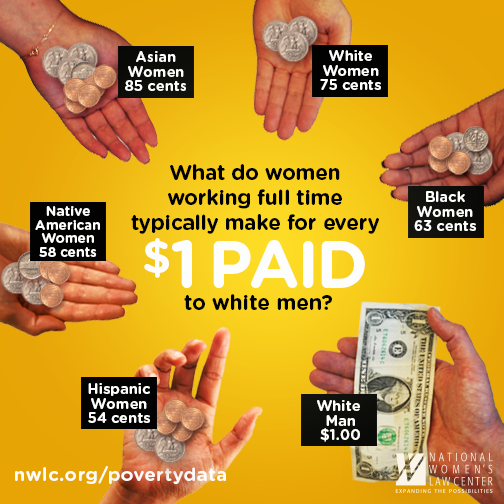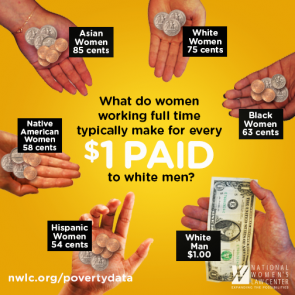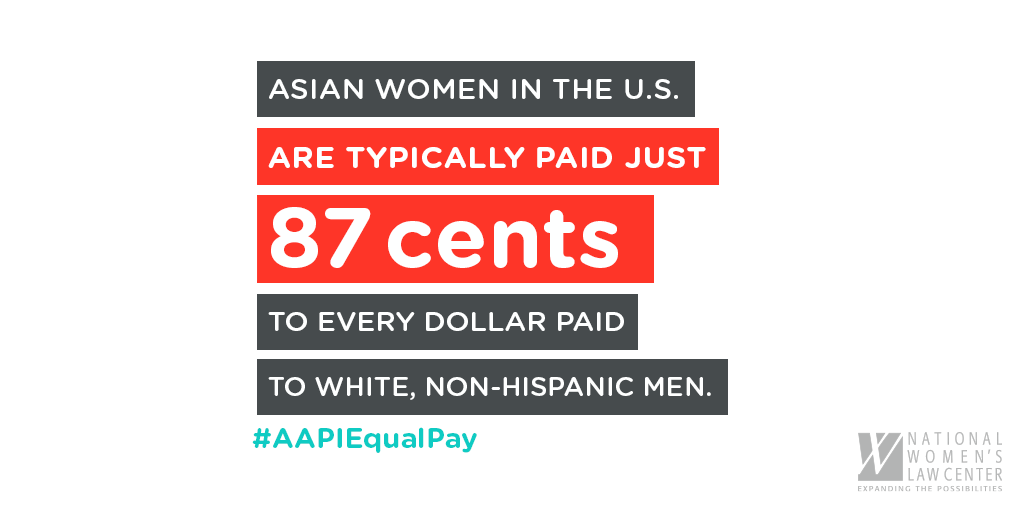Abortion rights, women of color, and LGBTQI+ people are under attack. Pledge to join us in fighting for gender justice.
However You Look at it, Women Deserve Equal Pay Every Day of the Year

 Equal Pay Day was a little over three weeks ago, reflecting the fact that women are typically paid only 80 cents to every dollar paid by men and thus have to work several months into 2017 to make what men made in 2016. We’re often asked whether Equal Pay Day is based on the wage gap for white women. Actually, it isn’t. Today is the day that white women catch up to what white men made in 2016. Allow us to explain.
Equal Pay Day was a little over three weeks ago, reflecting the fact that women are typically paid only 80 cents to every dollar paid by men and thus have to work several months into 2017 to make what men made in 2016. We’re often asked whether Equal Pay Day is based on the wage gap for white women. Actually, it isn’t. Today is the day that white women catch up to what white men made in 2016. Allow us to explain.
There are a lot of different ways to look at the wage gap, including by race and ethnicity. The overall 80 cents on the dollar number, which is what we highlight on Equal Pay Day every April, describes the wage gap for all women—including both white women and women of color—as compared to all men—including both white men and men of color. When we look at the wage gap for white women and women of color, it is compared to white, non-Hispanic men. When measuring the combined impact of race, ethnicity, and gender the gap is often larger, but that varies between specific groups of women.
For example, if we calculate the wage gap for white, non-Hispanic women separately, we find they are paid 75 cents for every dollar paid to white, non-Hispanic men, which means they would have to work until today to make their male counterparts made by December 31, 2016. Put another way, this means white women have to work sixteen months to get paid the same as a white man in twelve. That’s four extra months of work, just to get to the same place.
The wage gap for white women is larger than for women overall, but the gap is even wider for most women of color.
Black women are paid 63 cents for every dollar paid to white, non-Hispanic men and they lose $21,001 to the wage gap each year, which means they have to work an extra seven months to make what white, non-Hispanic men make in twelve. Native American women are paid 58 cents for every dollar paid to white, non-Hispanic men and they lose $23,356 to the wage gap each year, which means they have to work just about 21 months to make what white, non-Hispanic men make in twelve. And Latinas are paid 54 cents for every dollar paid to white, non-Hispanic men and lose $26,095 each year to the wage gap, which means they have to work more than 22 months to make what white, non-Hispanic men make in twelve. This means Black, Native, and Latina women have to work well into the second half of the next year just to break even with white men.
While Asian women have a smaller wage gap compared to other groups of women, when you break it down further, some subgroups of Asian women experience much larger gaps. We mark Asian Women’s Equal Pay Day on March 7, and while this represents the date to which Asian women must work to make what white men made in the previous year, looking at the wage gap for Asian women overall masks some of the disparities experienced by this diverse group of women. For example, while the wage gap for Asian women overall is 85 cents, Vietnamese women are paid only 64 cents, Cambodian women 55 cents, and Burmese women 44 cents for every dollar paid to white, non-Hispanic men.
No matter how you break it down, the bottom line is women deserve equal pay for equal work, every day of the year.





